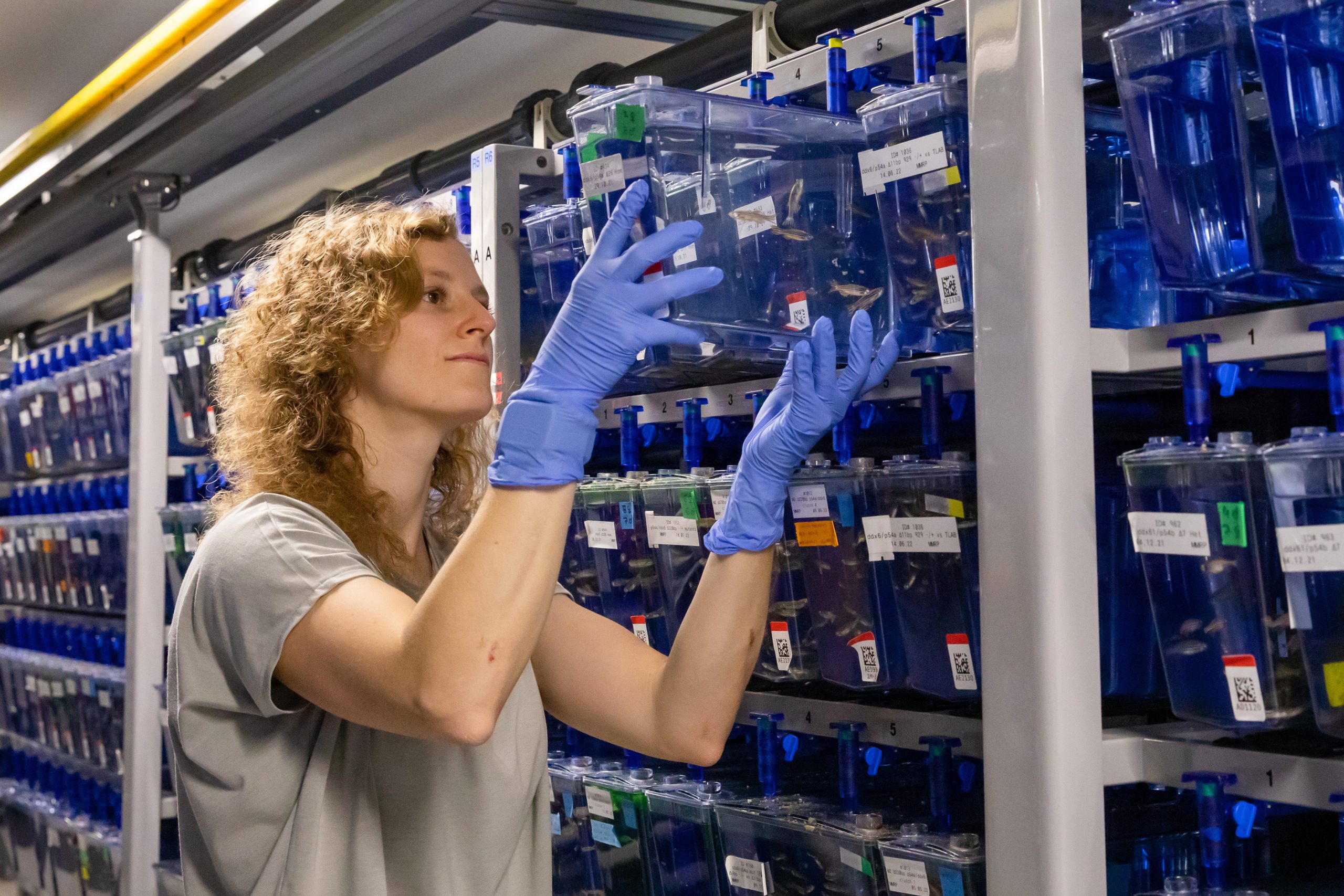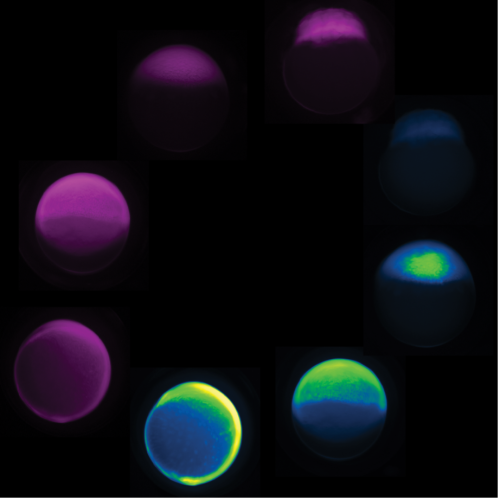Regulating mRNA translation at the start
Posted by Madalena Pinto, on 30 May 2025
Madalena M. Reimão Pinto (Schier lab, University of Basel, Switzerland) and Sebastian Castillo Hair (Seelig lab, Washington University, Seattle, USA) joined forces to understand how zebrafish embryos orchestrate protein synthesis during early development. Through this collaboration, their recently published study in Developmental Cell identifies features in mRNA 5′ UTRs that act during early zebrafish development to regulate translation.
Madalena, what brought you to Alex Schier’s lab and how did you embark on this project?
During my PhD at the Vienna BioCenter, I worked on understanding the molecular mechanisms regulating mRNA biogenesis and function in the fruit fly. It so happened that the exonucleolytic enzyme that I was working on at the time had a striking effect on spermatogenesis, and the data pointed to defects resulting from misregulated mRNA translation. By the end of my PhD, I was fascinated by mRNA translational control in the context of organismal development. I quickly realized that we lacked a comprehensive understanding of how mRNA translation initiation – which is rate limiting for protein production – is regulated during the very fast-paced and temporally coordinated stages of early embryogenesis. This motivated me to tackle this question in the context of early vertebrate development. I also realized that my background in RNA biochemistry gave me an edge to start studying developmental biology at a mechanistic level from a different perspective. I chose to address this question using the zebrafish model because it allows me to combine high-throughput approaches with biochemistry and powerful genetic tools in live embryos, as they develop.
I had heard great things about the Schier lab from Andi Pauli (Schier lab Alumna, group leader at the Vienna BioCenter, Austria) and was inspired by Michal Rabani’s work on mRNA stability during zebrafish embryogenesis (Schier lab Alumna, group leader at the Hebrew University of Jerusalem, Israel). On one hand, I was looking to join a lab which had in depth knowledge about developmental biology and zebrafish genetics; on the other hand, I wanted to be part of a multidisciplinary and vibrant group of people who aspired to become group leaders, so the Schier lab was the perfect choice.
The main question motivating my postdoctoral work is: how do embryos know how much protein to make and when? To start dissecting this question systematically, I decided to focus on the 5′ UTR sequence, which is crucial for regulating translation initiation, and developed an approach to interrogate at transcriptome scale how the 5′ UTR contributes to regulating translational dynamics as embryos develop.

How did the collaboration with the Seelig lab start?
Well, it took more than two years to get to a stage when I had designed and generated the 5′ UTR massively parallel reporter assay (MPRA) library, validated it and acquired the in vivo data. To be honest, I also spent quite some time running data analyses before convincing myself that the assay had actually worked and was recovering biologically meaningful information! Once I realized that was the case, I was super excited to try and learn as much from the data as possible. I was familiar with Georg Seelig’s work and had actually met him in person when he gave a talk at the Biozentrum’s Discovery Seminar. At that time, I was still running experiments but I approached Georg and asked if he would be interested in collaborating to explore the data with deep-learning models. Georg was excited about my project and told me to reach out when the right time came, and so I did! He then paired me up with Sebastian, and we started a wonderful collaboration together. Honestly, it was so efficient and so much fun: we would meet every two weeks, and at each meeting discuss our progress, come to an agreement on next analyses and experiments and then execute them. It gave the project a really nice momentum and it was just great to feel part of a team working towards a common goal. At the same time, Georg joined the Schier lab for a sabbatical, so it was great to have the opportunity to discuss and get feedback on a regular basis from both PIs in person. The project would have not been the same without Sebastian’s contributions, who developed the Danio Optimus 5-Prime (DaniO5P) deep-learning model to evaluate and interpret the 5′ UTR MPRA data. And Georg was the one who came up with the model’s name!
What were for you the most exciting findings, or particular moments during the project that stuck with you?
The most exciting moment was running the Kozak sequence and uORF analyses and realizing that the assay had actually technically worked. It also meant that the data likely contained additional sequence information to be uncovered, which was a super exciting prospect. And then of course, seeing motifs emerging from the motif enrichment analysis and the DaniO5P model!
I’d also like to say that when I started this project, I had no experience performing polysome profiling. I was extremely fortunate to meet Sunil Shetty, at the time a postdoc in the Hall group at the Biozentrum (now leading his independent research group at the Tata Memorial Centre in Mumbai, India), who taught me how to prepare sucrose gradients and perform polysome profiling. His happiness and positivity are contagious, and some of the most fun moments of my postdoc were spent next to the polysome profiling machine learning from Sunil. I am deeply grateful to him, and also to Michael Hall for kindly welcoming me in his lab.
And what was most challenging?
For sure it was starting my postdoc and having the COVID-19 pandemic hit a few months later. At the time, my plan was to experimentally define zebrafish 5′ UTRs by long-read sequencing to design the MPRA. There was so much uncertainty about when we could be back in the lab full time, that I decided to instead use an alternative approach to computationally infer 5′ UTR sequences from a public dataset of cap analysis of gene expression data. I don’t have a background in computational biology, so it was definitely a slow and iterative learning process – but also very rewarding in the end, and most importantly it allowed me to move forward with the project.
What’s ahead for you?
I am currently applying for Group Leader positions. Going on interviews and getting to meet faculty members from different research institutions is really an amazing and rewarding experience, but also very time-consuming, so it’s hard to get any experiments done alongside applications and interviews. I am super excited to start my own independent research group soon, and I hope to continue to collaborate with Sebastian on future projects!

development (from 2 to 10 hours post-fertilization) that were injected at
the 1-cell stage with a fluorescent dextran dye (magenta) and an mRNA
reporter encoding GFP (green), reminiscing of the moon phases.


 (1 votes)
(1 votes)